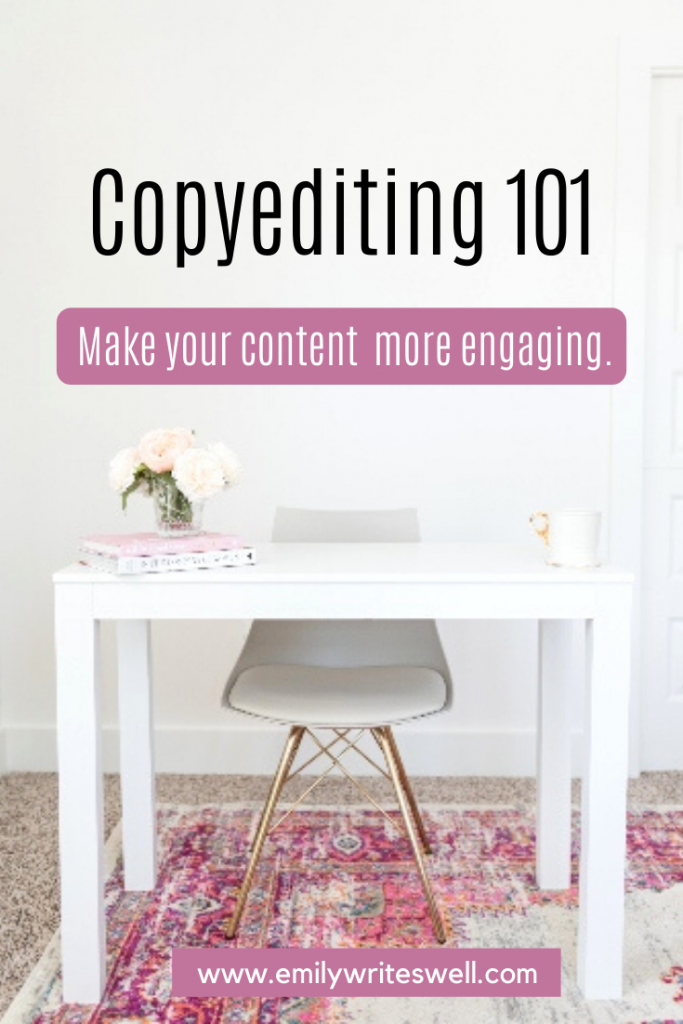Editing yourself is a tricky business. It can be hard to spot mistakes you don’t even realize are mistakes.

How to Edit Yourself
Where do you even start? Learning how to edit yourself is complicated. There’s a lot more to copyediting than just fixing misspellings and comma errors. You should check your work for clarity, comprehension, tone, word choice, and punctuation.
Copyediting is an integral part of educating, entertaining, and connecting with your audience. If no one understands what you’re saying, you aren’t actually communicating.
Reread Your Writing
Seriously. Reread the entire thing. Whether it’s an Instagram caption, a sales email, or a blog post– reread every. single. word.
If you’re checking for misspellings and grammatical errors, I highly suggest rereading backward. It will force you to slow down and actually notice each word, which helps you pick up on errors more easily. You can’t skim when reading backward.
Now that you’ve corrected most of your spelling and punctuation errors, reread your work out loud. Are your sentence patterns difficult to read? Does it all run into one monotonous blur that bores you? Are there weird pauses or choppy sentences that distract from your message? It’s a lot easier to hear those issues than it is if you only read in your head.
Check Frequently Misused Homophones
Homophones are words that sound the same but have different meanings. This is where a lot of us get tripped up. Spellcheck only catches spelling errors. It can’t tell you if you chose the wrong word altogether.
Some of the most commonly misused homophones:
their/there/they’re “They’re coming to pick up their bikes over there.”
here/hear “I hear that she will be here soon.”
peek/peak “I peeked out of the window at the mountain peak.”
to/too/two “Those two are going to the store, too.”
your/you’re “You’re going to have so much fun on your trip!”
accept/except “We must accept that we can’t do anything except wait.”
Delete the Fluff
“Substitute damn every time you’re inclined to write very; your editor will delete it and the writing will be just as it should be.”- Mark Twain
Most of us frequently overwrite, myself included. We use 27 words when 12 will do. Too many unnecessary words and your audience will check out.
Highlight any words you see repeated often. Very, really, good, best, many, over, other, great, and so are common culprits, but we all have our own specific fluff words we love to interject. Once you’ve highlighted the unnecessary words, delete almost all of them. Your writing will be clearer and easier to read.
Use the Active Voice
Blogs are what I write.
The results were felt by them all.
Yuck. No.
I write blogs.
They all felt the results.
What’s the difference? Active voice.
We bore and confuse readers when we use passive voice. There are a select number of times when passive voice is necessary or the better option, but use it sparingly.
Passive voice: object + verb + subject
We call it passive voice because the action is happening to the subject rather than the subject doing the action themselves.
Active voice: subject + verb +object
Active voice is more interesting and direct. You also usually use fewer words to communicate your message in active voice.
Your writing is clearer and more engaging when you change passive sentences to active voice!
Write in a Separate Document
Don’t write your copy in the platform you’re using. Keeping your writing in a separate document will make it easier to edit and keep you focused on the words. This is a good practice for Instagram captions, blog posts, email templates, and website copy.
Make Grammar Girl Your Best Friend
Grammar Girl is less dramatic than Gossip Girl, but it’s incredibly helpful. Grammar Girl is part of the Quick and Dirty Tips network and essentially gives direct, simple, easy to understand answers to complicated or confusing grammar questions. I looked up ‘backward or backwards’ on Grammar Girl while writing this blog post. (Apparently backward is the American spelling and backwards is the British spelling, but only when the word is used as adverb.) I use this site at least three times a day to check on word choice, whether to use a hyphen, or any number of grammar questions.
We could go on, but I think this is a really solid starting place for self-editing. It takes time to do a solid edit, even on a short caption. But what’s the point of communicating with your audience if you aren’t actually saying what you want to say? Take the time and do the edit.
The more you practice, the better you’ll get!
And if you're looking to find your brand voice while you're improving your editing skills download this interactive brand voice guide to identify your unique brand voice!


view + leave comments . . .